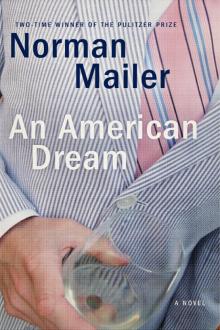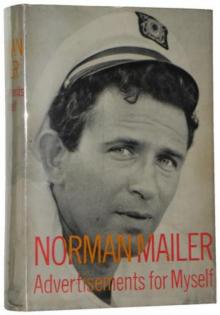- Home
- Norman Mailer
Miami and the Siege of Chicago
Miami and the Siege of Chicago Read online
NEW YORK REVIEW BOOKS
CLASSICS
MIAMI AND THE SIEGE OF CHICAGO
NORMAN MAILER (1923–2007) was born in Long Branch, New Jersey, and grew up in Brooklyn, New York. In 1955 he co-founded The Village Voice. He is the author of more than thirty books, including The Naked and the Dead; The Armies of the Night, for which he won a National Book Award and the Pulitzer Prize; The Executioner’s Song, for which he won his second Pulitzer Prize; Harlot’s Ghost; Oswald’s Tale; The Gospel According to the Son; and The Castle in the Forest.
FRANK RICH is a columnist for The New York Times. His books include Ghost Light, a memoir, and The Greatest Story Ever Sold: The Decline and Fall of Truth in Bush’s America.
MIAMI AND THE SIEGE OF CHICAGO
An Informal History of the Republican and Democratic Conventions of 1968
NORMAN MAILER
Introduction by
FRANK RICH
NEW YORK REVIEW BOOKS
New York
CONTENTS
Biographical Notes
Title Page
Introduction
Miami and the Siege of Chicago
Dedication
Epigraph
I. NIXON IN MIAMI: Miami Beach, August 3–9
II. THE SIEGE OF CHICAGO: Chicago Beach, August 24–29
Copyright and More Information
INTRODUCTION
It’s not only America that was at a crossroads in the summer of 1968. When Norman Mailer covered the Republican and Democratic conventions on assignment for Harper’s magazine, he was forty-five, an aging rebel looking for a new cause. He had started to drift restlessly from his single-minded pursuit of the Great American Novel into filmmaking and journalism, two callings that were also in the throes of seismic generational change.
Mailer juggled his reporting forays to Miami and Chicago with the shooting of Maidstone, his most ambitious contribution to the new wave of American independent cinema. Miami and the Siege of Chicago, meanwhile, was his latest contribution to a literary revolution that had been fomented throughout the decade by a pair of iconoclastic magazine editors, Harold Hayes of Esquire and Willie Morris of Harper’s. Mailer’s take on the 1960 Democratic convention for Esquire, “Superman Comes to the Supermarket,” had been an early salvo. By 1968, Tom Wolfe (The Electric Kool-Aid Acid Test), Hunter S. Thompson (Hell’s Angels), and, at The New Yorker, Truman Capote (In Cold Blood), had created nonfiction “novels” that upended the staid conventions of newspaper and magazine writing by injecting strong subjective voices, self-reflection, opinion, and, most of all, good writing that animated current events and the characters who populated them. Mailer’s book-length recounting of the 1967 march on the Pentagon, The Armies of the Night (subtitled History as a Novel, the Novel as History), had arguably been his most well-received literary venture since The Naked and the Dead. Miami and the Siege of Chicago was its eagerly awaited sequel.
New Journalism was a much-needed antidote to the status quo. Early in Miami, Mailer rubs in the point by reprinting a New York Times account of a confrontation he had missed between white Republican delegates and black demonstrators in the unlikely setting of Miami Beach’s Fontainebleau Hotel. Unable to glean the feel or meaning of this episode from the newspaper’s account, Mailer writes, “It was a good story but the Times was not ready to encourage its reporters in the thought that there is no history without nuance.” But the battle had in fact already been won elsewhere: New Journalism had even established an outpost in the Times’s former competitor, the New York Herald Tribune, where another cheeky editor, Clay Felker, created New York magazine, the high-style Sunday supplement that became a stand-alone weekly in 1968 after the paper’s demise. When Mailer describes running into William Burroughs and Jean Genet in Lincoln Park in Chicago, he doesn’t mention that even these unlikely figures had now been drafted into the journalistic ranks; both were covering the Democrats for Esquire.
The American tumult of the 1960s required a new language to chronicle it. As Mailer writes, “It was as if the historical temperature in America went up every month.” What happened in America in 1968—Lyndon Johnson’s unexpected decision not to seek reelection, two assassinations, spiraling urban and campus riots—was just too explosive to be contained by the tidy columns of a newspaper’s front page. Nor could it be captured in book form by a journalistic mandarin like Theodore H. White, whose Time-bred access to (and trust in) establishment sources was a tonic in The Making of the President 1960 but proved ill equipped to deal with the chaotic bottom-up politics generated by the civil rights and antiwar movements. Even the relatively conventional Nixon campaign of 1968 was better captured by an upstart New Journalist, the twenty-six-year-old Joe McGinniss, whose Selling of the President gently mocked White’s title and stole his thunder on the best-seller list.
In lesser hands, New Journalism could also be a recipe for self-indulgence, solipsism, and mischievous fictionalization, but that is not the case with Miami and the Siege of Chicago. Mailer’s book holds up better than most political journalism written last week, let alone four decades ago. Indeed it survives better than it has any right to—as history, as literature, and as a portrait of America both then and now.
As a narrative of the summer’s actual political events it is both compactly comprehensive and dead-on, often hilariously so. And not just when serving up Richard Nixon. Mailer’s Dickensian portraiture revivifies even the half remembered. Eugene McCarthy seemed less a presidential prospect than “the dean of the finest English department in the land.” John Connally boasted “a thin-lipped Texas grin, a confident grin—it spoke of teeth which knew how far they could bite into every bone, pie, nipple or tit.” Hubert Humphrey employed “a formal slovenliness of syntax which enabled him to shunt phrases back and forth like a switch-man who locates a freight car by moving everything in the yard.” Mayor Richard Daley looked at his worst “like a vastly robust peasant woman with a dirty gray silk wig” and at his best “respectable enough to be coach of the Chicago Bears.”
The accounts of both conventions begin with definitive appreciations of the antithetical American cities where they took place. Mailer marvels that the Grand Old Party, “the party of conservatism and principle, of corporate wealth and personal frugality, the party of cleanliness, hygiene, and balanced budget, should have set itself down on a sultan’s strip.” In Chicago, which he rightly celebrates as “the great American city,” he apotheosizes both the “clean tough keen-eyed ladies” of the near North Side and “the fear and absolute anguish of beasts dying upside down” at the slaughterhouses. By the time Daley’s beastly police set off the massacre of Michigan Avenue, Mailer has painted an urban landscape vivid enough to ground his metaphor: “The Democratic party had broken in two before the eyes of a nation like Melville’s whale charging right out of the sea.”
For all Mailer’s ability to make the present real, he sees a bigger picture that is, in retrospect, remarkably prescient about the future. His book is haunted by delicate invocations of an avatar of post-1968 racial politics who never appears in close-up, George Wallace. The cameo glimpses of a B-list player, Ronald Reagan, seem to prefigure the California governor’s ultimate ascension from the ashes of Goldwaterism. Mailer sees clearly the political death rattles of the old WASP aristocracy, destined to “grow more insane each year, like a rich nobleman in an empty castle chasing elves and ogres with his stick.” He recognizes just what it means when newly converted Southern Republicans, exemplified by the former Dixiecrat Strom Thurmond, seal the selection of Spiro Agnew as Nixon’s running mate over the last tribunes of Rocke-feller progressivism (Charles Percy, Mark Hatfield, John Lindsay). The intellectual foundations
of the political establishment’s anticommunism, Mailer observes, would soon “split into its separate parts.”
The Republicans “did not deserve the presidency, never,” he concludes. Yet he is dubious about the prospects for the Democrats in the wake of their Vietnam implosion:
The Left was not ready, the Left was years away from a vision sufficiently complex to give life to the land, the Left had not yet learned to talk across the rugged individualism of the more rugged America, the Left was still too full of kicks and pot.... The Left could also find room to grow up. If the Left had to live through a species of political exile for four or eight or twelve good years, it might even be right. They might be forced to study what was alive in the conservative dream.
And where does that leave the author? As he says, in a typical third-person construction, “the reporter stood in the center of the American Scene.” Unlike so many on the ramparts of 1968, Mailer is genuinely ambivalent. Now that Bobby Kennedy is gone, he is left to contemplate the Yippies in Lincoln Park with their signs of VOTE PIG IN 68: “Were those unkempt children the sort of troops with whom one wished to enter battle?” He frets that Vietnam and “Black Power” are “pushing him to that point where he would have to throw his vote in with revolution,” and asks, “What price was he really willing to pay?”
This question is not resolved by the end of the book, which finds the author, manhandled but unbowed by Daley’s thugs, repairing to the revels at Hugh Hefner’s Playboy mansion. But Mailer knows the trajectory that lies ahead for the country. “We will be fighting for forty years,” he suggests. Perhaps he thought that was hyperbole at the time, but we now know it was portent.
Mailer also knew where journalism was headed. The politicians, he noticed, “rushed forward to TV men, and shouldered notepads aside.” When he misses an exciting night on the convention floor, he consoles himself “with the sad knowledge that he could cover it better on television than if he had been there.” He predicts that “soon they would hold conventions in TV studios.”
Mailer’s election-year chronicle has its progeny—most notably Hunter Thompson’s Fear and Loathing: On the Campaign Trail ’72 and Richard Ben Cramer’s opus of the 1988 race, What It Takes—but its literary energy and intellectual independence remain the exception rather than the rule in American campaign coverage. For all the books churned out each election cycle, they are often throwbacks to Teddy White, not Mailer and Thompson. Much of what passes for political reportage now in print, whether on paper or on a Web site, succumbs to the same kind of smallbore pack mentality that Mailer set out to vanquish. Open up Miami and the Siege of Chicago to any page and you’ll see how American journalism flowered even as the country lost its way.
—FRANK RICH
MIAMI AND THE SIEGE OF CHICAGO
To my father
Nothing Infuriates the Natives of Miami Beach More Than to Be Confused with Miamians.
—MIAMI BEACH CHAMBER OF COMMERCE
I. NIXON IN MIAMI:
Miami Beach, August 3–9
1
They snipped the ribbon in 1915, they popped the cork, Miami Beach was born. A modest burg they called a city, nine-tenths jungle. An island. It ran along a coastal barrier the other side of Biscayne Bay from young Miami—in 1868 when Henry Lum, a California ‘forty-niner, first glimpsed the island from a schooner, you may be certain it was jungle, cocoanut palms on the sand, mangrove swamp and palmetto thicket ten feet off the beach. But by 1915, they were working the vein. John S. Collins, a New Jersey nurseryman (after whom Collins Avenue is kindly named) brought in bean fields and avocado groves; a gent named Fisher, Carl G., a Hoosier—he invented Prestolite, a millionaire—bought up acres from Collins, brought in a work-load of machinery, men, even two elephants, and jungle was cleared, swamps were filled, small residential islands were made out of baybottom mud, dredged, then relocated, somewhat larger natural islands adjacent to the barrier island found themselves improved, streets were paved, sidewalks put in with other amenities—by 1968, one hundred years after Lum first glommed the beach, large areas of the original coastal strip were covered over altogether with macadam, white condominium, white luxury hotel and white stucco flea-bag. Over hundreds, then thousands of acres, white sidewalks, streets and white buildings covered the earth where the jungle had been. Is it so dissimilar from covering your poor pubic hair with adhesive tape for fifty years? The vegetal memories of that excised jungle haunted Miami Beach in a steam-pot of miasmas. Ghosts of expunged flora, the never-born groaning in vegetative chancery beneath the asphalt came up with a tropical curse, an equatorial leaden wet sweat of air which rose from the earth itself, rose right up through the baked asphalt and into the heated air which entered the lungs like a hand slipping into a rubber glove.
The temperature was not that insane. It hung around 87 day after day, at night it went down to 82, back to the same 87 in the A.M.—the claims of the News Bureau for Miami Beach promised that in 1967 temperature exceeded 90° only four times. (Which the Island of Manhattan could never begin to say.) But of course Miami Beach did not have to go that high, for its humidity was up to 87 as well —it was, on any and every day of the Republican Convention of 1968, one of the hottest cities in the world. The reporter was no expert on tropical heats—he had had, he would admit, the island of Luzon for a summer in World War II; and basic training in the pine woods of Fort Bragg, North Carolina, in August; he had put in a week at Las Vegas during July—temperatures to 110; he had crossed the Mojave Desert once by day; he was familiar with the New York subway in the rush hour on the hottest day of the year. These were awesome immersions—one did not have to hit the Congo to know what it was like in a hothouse in hell—but that 87° in Miami Beach day after day held up in competition against other sulphuric encounters. Traveling for five miles up the broken-down, forever in-a-state-of-alteration and repair of Collins Avenue, crawling through 5 P.M. Miami Beach traffic in the pure miserable fortune of catching an old taxi without air conditioning, dressed in shirt and tie and jacket—formal and implicitly demanded uniform of political journalists—the sensation of breathing, then living, was not unlike being obliged to make love to a 300-pound woman who has decided to get on top. Got it? You could not dominate a thing. That uprooted jungle had to be screaming beneath.
Of course it could have been the air conditioning: natural climate transmogrified by technological climate. They say that in Miami Beach the air conditioning is pushed to that icy point where women may wear fur coats over their diamonds in the tropics. For ten miles, from the Diplomat to the Di Lido, above Hallandale Beach Boulevard down to Lincoln Mall, all the white refrigerators stood, piles of white refrigerators six and eight and twelve stories high, twenty stories high, shaped like sugar cubes and ice-cube trays on edge, like mosques and palaces, shaped like matched white luggage and portable radios, stereos, plastic compacts and plastic rings, Moorish castles shaped like waffle irons, shaped like the baffle plates on white plastic electric heaters, and cylinders like Waring blenders, buildings looking like giant op art and pop art paintings, and sweet wedding cakes, cottons of kitsch and piles of dirty cotton stucco, yes, for ten miles the hotels for the delegates stood on the beach side of Collins Avenue: the Eden Roc and the Fontainebleau (Press Headquarters), the Di Lido and the De Lano, the Ivanhoe, Deauville, Sherry Frontenac and the Monte Carlo, the Cadillac, Caribbean and the Balmoral, the Lucerne, Hilton Plaza, Doral Beach, the Sorrento, Marco Polo, Casablanca, and Atlantis, the Hilyard Manor, Sans Souci, Algiers, Carillon, Seville, the Gaylord, the Shore Club, the Nautilus, Montmartre, and the Promenade, the Bal Harbour on North Bay Causeway, and the Twelve Caesars, the Regency and the Americana, the Diplomat, Versailles, Coronado, Sovereign, the Waldman (dig!), the Beau Rivage, the Crown Hotel, even Holiday Inn, all oases for technological man. Deep air conditioning down to 68°, ice-palaces to chill the fevered brain—when the air conditioning worked. And their furnishings were monumentally materialistic. Not all of them: the cheaper downtown hotels li
ke the Di Lido and the Nautilus were bare and mean with vinyl coverings on the sofas and the glare of plastic off the rugs and tables and tiles, inexpensive hotel colors of pale brown and buff and dingy cream, sodden gray, but the diadems like the Fontainebleau and the Eden Roc, the Doral Beach, the Hilton Plaza (Headquarters for Nixon), the Deauville (Hq for Reagan) or the Americana—Rockefeller and the New York State delegation’s own ground—were lavish with interlockings, curves, vaults and runs of furnishings as intertwined as serpents in the roots of a mangrove tree. All the rivers of the very worst taste twisted down to the delta of each lobby in each grand Miami Beach hotel—rare was the central room which did not look like the lobby of a movie palace, imitation of late-Renaissance imitations of Greek and Roman statues, imitations of baroque and rococo and brothel Victorian and Art Nouveau and Bauhaus with gold grapes and cornucopias welded to the modern bronze tubing of the chair, golden moldings which ran like ivy from room to room, chandeliers complex as the armature of dynamos, and curvilinear steps in the shape of amoebas and palettes, cocktail lounge bars in deep rose or maroon with spun-sugar white tubes of plaster decor to twist around the ceiling. There was every color of iridescence, rainbows of vulgarity, aureoles of gorgeous taste, opium den of a middle-class dollar, materialistic as meat, sweat, and the cigar. It is said that people born under Taurus and Capricorn are the most materialistic of us all. Take a sample of the residents in the census of Miami B.—does Taurus predominate more than one-twelfth of its share? It must, or astrology is done, for the Republicans, Grand Old Party with a philosophy rather than a program, had chosen what must certainly be the materialistic capital of the world for their convention. Las Vegas might offer competition, but Las Vegas was materialism in the service of electricity—fortunes could be lost in the spark of the dice. Miami was materialism baking in the sun, then stepping back to airconditioned caverns where ice could nestle in the fur. It was the first of a hundred curiosities—that in a year when the Republic hovered on the edge of revolution, nihilism, and lines of police on file to the horizon, visions of future Vietnams in our own cities upon us, the party of conservatism and principle, of corporate wealth and personal frugality, the party of cleanliness, hygiene, and balanced budget, should have set itself down on a sultan’s strip.

 Ancient Evenings
Ancient Evenings The Gospel According to the Son
The Gospel According to the Son Oswald's Tale: An American Mystery
Oswald's Tale: An American Mystery The Castle in the Forest
The Castle in the Forest The Executioner's Song
The Executioner's Song Why Are We in Vietnam?
Why Are We in Vietnam? The Deer Park: A Play
The Deer Park: A Play An American Dream
An American Dream Why Are We at War?
Why Are We at War? The Time of Her Time
The Time of Her Time The Spooky Art: Thoughts on Writing
The Spooky Art: Thoughts on Writing Miami and the Siege of Chicago
Miami and the Siege of Chicago Mind of an Outlaw: Selected Essays
Mind of an Outlaw: Selected Essays Barbary Shore
Barbary Shore The Fight
The Fight Harlot's Ghost
Harlot's Ghost Tough Guys Don't Dance
Tough Guys Don't Dance Of a Fire on the Moon
Of a Fire on the Moon The Spooky Art
The Spooky Art The Deer Park
The Deer Park On God: An Uncommon Conversation
On God: An Uncommon Conversation Mind of an Outlaw
Mind of an Outlaw Oswald's Tale
Oswald's Tale